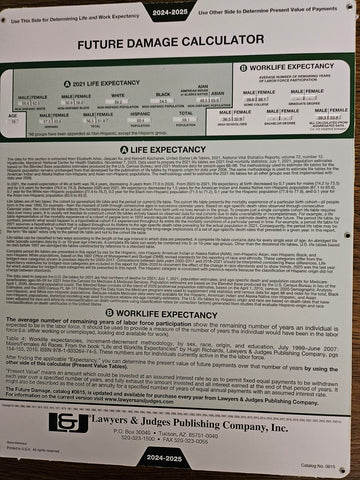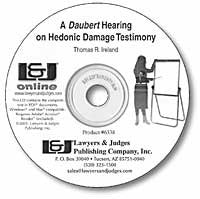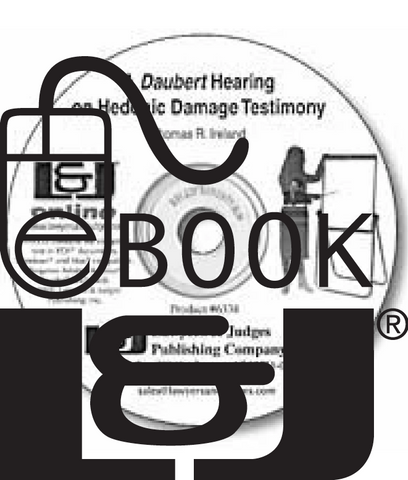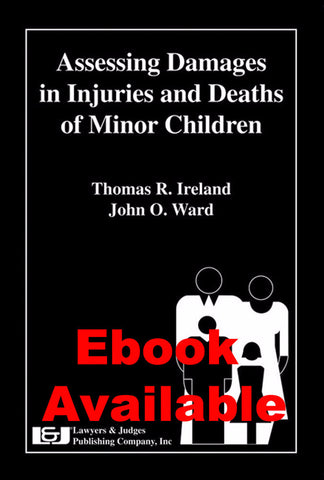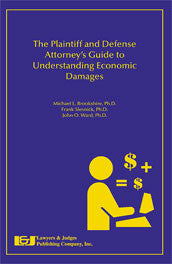
Plaintiff and Defense Attorney's Guide to Understanding Economic Damages
- Author: Michael L. Brookshire, Frank Slesnick, John O. Ward
-
ISBN 10: 1-933264-10-1
-
ISBN 13: 978-1-933264-10-3
-
Copyright Date Ed: June 1, 2007
-
Pages: 193 pages
-
Binding Information: Paperback plus CD-ROM
- Size: 6 ✕ 9 Inches (US)
The Plaintiff and Defense Attorney's Guide to Understanding Economic Damages is an informative yet compact book pertaining to the use of economic damage testimony in trial or mediation. It will be a valuable part of your library as an attorney needing to understand the practical issues involved with retaining economic expert witnesses and using economic testimony in your upcoming trial or mediation. This is an essential resource for damages expert wishing to understand the legal perspective of their work.
Inside is a wealth of information on many important topics on understanding economic damages and using them to your benefit, whether you are the plaintiff or defense attorney. It covers estimation of wage and salary loss, fringe benefit loss, household services loss, estimating losses for adults and children, and understanding and retaining economic damage experts.
You’ll also read about the roles of life care planners and vocational/rehabilitation experts and how they help determine economic damages. Special cases and issues—such as punitive damages, F.E.L.A. cases involving injured railroad workers, international issues, gender, age, ethnic background, and more—are covered in great depth. You’ll also learn how to achieve a successful result in mediation and trial situations, on both the plaintiff and defense side. Structured settlements, and their advantages and disadvantages, are extensively covered.
The accompanying CD-ROM includes Internet sources with additional information, definitions of technical terminology, direct and cross-examination questions and answers, case studies, links to damage calculation sites, and more.
This book is also available as an eBook. Click here to purchase and download:
Topics Include:
- Understanding economic damage experts
- Daubert considerations
- Plaintiff attorney's considerations and perspectives
- Defense attorney's considerations and perspectives
- Estimating lost earnings
- Valuing fringe benefits
- Household service losses
- Vocational/Rehabilitation experts
- Life care planners
- Medical care costs
- Personal injury
- Wrongful death
- Effects of age, gender, and ethnic background
- Punitive Damages
- F.E.L.A. issues
- International issues
- Mediation and trial practice
- Structured Settlements
Table of Contents
Chapter 1: Understanding Experts on Damage Valuation
1.1 It Ends With Dollars
1.2 Facts and Assumptions
1.3 Elements of Damages Considered
1.4 Sources of Foundation
1.5 Methodology Used
1.6 Damages Presentation
1.7 Credentials of Damages Experts
1.8 Where Do You Find Quality Experts?
1.9 The Daubert Age
1.10 Is Economic Testimony Scientific?
1.11 Conclusions
Chapter 2: The Trial Attorney’s View on Choosing and Using Economists and Related Experts on Damages
2.1 Why Retain an Economist?
A. Plaintiff’s considerations
B. Defense considerations
2.2 Choosing Your Expert on Damages
A. Daubert considerations
2.3 The Use of a Forensic Economist in Litigation
A. When to hire the economist
B. Discovery
C. Trial considerations for plaintiffs
D. Trial considerations for defendants
E. Economist and related damage experts
Chapter 3: Issues in the Estimation of Wage and Salary Losses
3.1 Introductory Issues
3.2 Conceptual Foundations for Estimating Lost Earnings
3.3 Distinction Between Expected Earnings and Earning Capacity
3.4 Determinants of Base Earnings
3.5 Determinants of the Future Rate of Increase in Base Earnings
3.6 Issues Related to Worklife
3.7 Bringing Future Dollars Back to the Present—the Discount Rate Issue
3.8 Some Comments Concerning Economists Hired By the Defense
3.9 Final Comments
Chapter 4: Fringe Benefits Losses
4.1 Introduction
4.2 Collecting Information Needed to Value Employer-Provided Fringe Benefits
4.3 Types of Fringe Benefits and Their Relative Importance
4.4 Placing a Value on Fringe Benefits and Issues That Arise
4.5 Valuing Fringe Benefits When a Young Person Is Injured
4.6 Valuing Fringe Benefits When an Employed Person Is Injured
A. Health insurance
B. Retirement benefits
4.7 Valuing Fringe Benefits When an Employed Person Is Killed
Chapter 5: Household Services Losses
5.1 Introduction
5.2 The Nature of Service Loss
5.3 Methods of Inventorying Service Loss
5.4 Resources Related to Service Loss
5.5 Conclusion
Chapter 6: The Vocational/Rehabilitation Expert
6.1 Introduction
6.2 Defining a Vocational Rehabilitation Expert
6.3 Vocational Rehabilitation Expert Credentials
6.4 Methodology and Process Utilized by Vocational Rehabilitation Experts
6.5 Records Required for Vocational Rehabilitation Expert Evaluation
6.6 Pre-Injury versus Post-Injury Evaluation
6.7 Evaluation of Earning Capacity in Pediatric Cases
6.8 Earnings versus Earnings Capacity
6.9 Evaluation of Individuals with Preexisting Earning Capacity Disabilities
6.10 Post-Injury Earning Capacity Evaluation—What Information to Use?
6.11 Barriers to Vocational Rehabilitation Evaluation
6.12 Interface with Forensic Economists and other Experts
6.13 Summary
Chapter 7: Issues of Life Care Planners and Medical Care Costs
7.1 Introduction
7.2 What is a Life Care Plan?
7.3 Education/Training of a Life Care Planner
7.4 Roles of the Life Care Planner
7.5 The Life Care Planning Process
7.6 Communication With Case Experts and Other Professionals
7.7 Specific Economic Issues Related to Life Care Plans
Chapter 8: Wrongful Death Cases and Personal Consumption Deductions
8.1 Introduction
8.2 The Differing Legal Parameters
8.3 Alternative Methods and Data Sources
8.4 Two Earner Households
8.5 Single Persons
8.6 Final Comments
Chapter 9: Less Tangible Damages
9.1 Background
9.2 Survey of Economists
9.3 Measuring the Value of a Statistical Life
9.4 Wrongful Death
9.5 Personal Injury
9.6 Ancillary Material
Chapter 10: Some Special Cases and Issues
10.1 The (Lost) Earnings Base
10.2 Some Special Issues of Age
10.3 The Effects of Gender and Race
10.4 Special Occupations
10.5 Special "Injuries"—Wrongful Termination
10.6 Summary and Conclusion
Chapter 11: The Special Issues of F.E.L.A. Cases
11.1 Calculating Damages under the F.E.L.A. for Injured Railroaders
11.2 Key Information
11.3 Components of Railroader Earnings
11.4 Issues with Offsets to Railroader Earnings
11.5 Retirement Benefits
11.6 Worklife Expectancy
11.7 Summary
Chapter 12: Punitive Damages
12.1 Introduction
12.2 Alternative Approaches
12.3 Judicial Guidelines
12.4 Optimal Deterrence
12.5 Punish But Not Destroy
12.6 The State Farm v. Campbell Exception
12.7 Disgorgement of Profits and Comparable Civil Fines
12.8 Summary and Conclusion
Chapter 13: Inside the Mediation Experience: Proof, Practice, and Preparation
13.1 Introduction
13.2 Three Styles of Mediation
13.3 Role of the Mediator
13.4 Role of the Mediation Advocate
13.5 Convening the Mediation
13.6 The Opening Session
13.7 The Caucus
13.8 Negotiation Models and Objectives
13.9 Documenting the Deal
13.10 Ethical Issues
13.11 Summary
Chapter 14: Structured Settlements
14.1 Introduction
14.2 Advantages and Disadvantages
14.3 When Structured Settlements Are Used
14.4 The Role of the Economist Evaluating Structured Settlements—The Defense Perspective
14.5 The Role of the Economist Evaluating Structured Settlements—The Plaintiff’s Perspective
14.6 Concluding Comments
Chapter 15: The Plaintiff Attorney’s Perspective on Economic Damages at Trial
15.1 Types of Economic Damages in Personal Injury Cases
15.2 Types of Economic Damages in Wrongful Death Cases
15.3 Presenting Economic Damages at Trial
Chapter 16: A Defense Trial Lawyer on Damage Issues at Deposition and Trial
16.1 Introduction
16.2 Success Begins Long Before Trial: The "Discovery" Process
16.3 When Do You Retain the Defense Economist?
16.4 The "Data" You Need for Depositions
16.5 Structuring the Examination at Deposition
16.6 What Was Done and What Was Not Done by the Economist
16.7 Specific "Discovery" Areas
16.8 The Dilemma: Do You Use a Defense Economist?
16.9 Preparing the Defense Economist for Deposition
16.10 Trial Considerations
16.11 Conclusion
Chapter 17: International Issues in Economic Damages17.1 Overview
17.2 The Foreign National Plaintiff in the U.S
17.3 The Foreign National in the Foreign Country with U.S. Jurisdiction
17.4 The U.S. National or Foreign National in a Foreign Country with Foreign Jurisdiction
17.5 Summary

